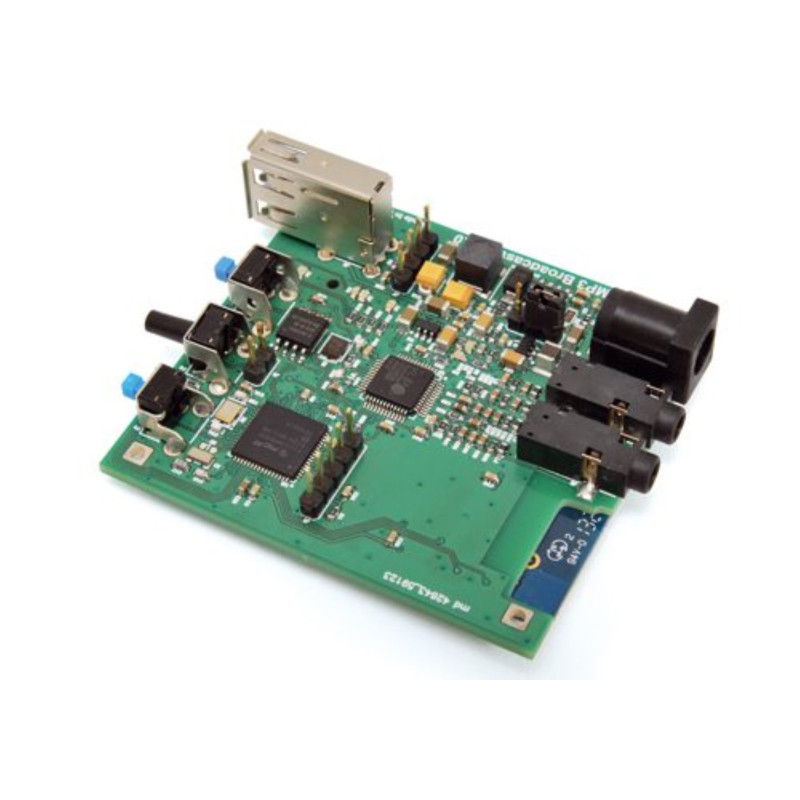










In practice it is a WiFi Broadcaster and allows, in transmitter mode, to sample an analog audio signal and transmit the corresponding digital stream to another homologous device or to any digital player compatible with the standards used (SHOUTcast and IceCast). Set by receiver will reconstruct the previously digitized analog signal.
 Secure Payments
Secure Payments
Pay safely with Credit Card, PayPal, Amazon Pay or Bank Transfer
 Fast Shipping
Fast Shipping
We ship across Europe and worldwide with UPS, DHL and DPD
 30-Day Easy Return
30-Day Easy Return
You have 30 days from delivery to return the product if you're not satisfied
Device based on the Microchip MRF24WG0MA Wi-Fi module, on the VS1063A-L chip produced by VLSI and managed by the Microchip PIC32MX695F512H-80I/MR microcontroller. It uses the protocols defined by the IEEE 802.11 standard to create wireless connections and broadcast music or customized audio messages in any room of a house, an office and in general any place, using the Wi-Fi network as communication infrastructure.
In practice it is a WiFi Broadcaster and allows, in transmitter mode, to sample an analog audio signal and transmit the corresponding digital stream to another homologous device or to any digital player compatible with the standards used (SHOUTcast and IceCast). Set by receiver will reconstruct the previously digitized analog signal. The WiFi Broadcaster is also compatible with the Ethernet Broadcaster, therefore it is possible to create both homogeneous systems, therefore composed exclusively of WiFi modules, and heterogeneous systems, composed of wireless modules and wired modules.
In relation to the solution chosen, the use of a common network Access Point will be necessary or not, in fact, if you choose to use only the WiFi modules it will be possible to configure a unit in SoftAP mode and connect up to 4 modules (clients) to the virtual access point, thus creating a private network of broadcasters only.
It has a USB Host connector capable of hosting a common USB key (Mass Storage device). The type of supported devices is very wide, most of the common USB flash drives or microSD adapters can be used without problems, the main limitation derives from the type of formatting that these mass devices must have, the software we have created is able to recognize only FAT16 or FAT32 formatting and is compatible with long file names. It is also equipped with a DC plug to supply power (between 7 V and 15 V – 500 mA), three buttons and four LEDs.
USEFUL MANUAL LINKS
Application scenarios
The configuration of the usage scenarios, the audio quality, as well as the streaming URLs, is possible, as in the Ethernet Broadcaster, via a common web browser. For this purpose, we recommend using a browser that supports HTML5 and JavaScript in order to correctly display all parameters, including those generated dynamically. The configuration of the WiFi modules is very simple, because each module is configured as a virtual Access Point when it is first switched on, so it will be possible to use a personal computer or a smartphone to connect to the virtual WiFi network (default name: BROADCASTER) in order to later access the configuration page and set the appropriate parameters.
In Fig. 1 (Local Network) you can see how it is possible to choose whether to continue using the default SoftAP mode or, alternatively, connect as a client to a pre-existing WiFi network, such as the one at home.
In both cases (SoftAP or ClientAP) you can choose different levels of security among: None, WEP-64bit, WEP-128bit and WPA. When choosing WEP privacy for SoftAP mode, you can choose between two levels of security: 64-bit WEP and 128-bit WEP. In both cases it is possible to type a password in the passphrase field and use the hexadecimal code generated in the WEP key field as the WiFi network authentication key, an example is shown in Fig. 2.
To make a connection with a physical AP, simply click on the name of the network that will appear in the list and then choose the type of privacy required by entering the authentication key. In the case of connection to a network protected with WEP it will be necessary to enter the hexadecimal code corresponding to the passphrase used by the physical AP in the passphrase field, while in the case of WPA/WPA2 it will be necessary to enter the entire authentication passphrase.
The device will memorize the keys inside its own memory and in the future will show this empty field. When the module is used as a SoftAP, a DHCP Server will also be started which will assign a dynamic IP to any connected device, be it a PC, a smartphone or another WiFi module. In the latter mode it is possible to connect up to four clients simultaneously to the same module. Conversely, when the module works as a ClientAP, and therefore an access point to connect to is selected, the device can use a dynamic IP provided via DHCP or it will be possible to assign a static IP.
Fig. 3 shows the possibility of listening to a web radio via the WiFi Broadcaster module. In this case the only parameters to be set are the Remote address, the Remote path and the Remote port, for example to connect to the radio
Italian “Radio Company” the parameters are: ice05.fluidstream.net, / and 7050.